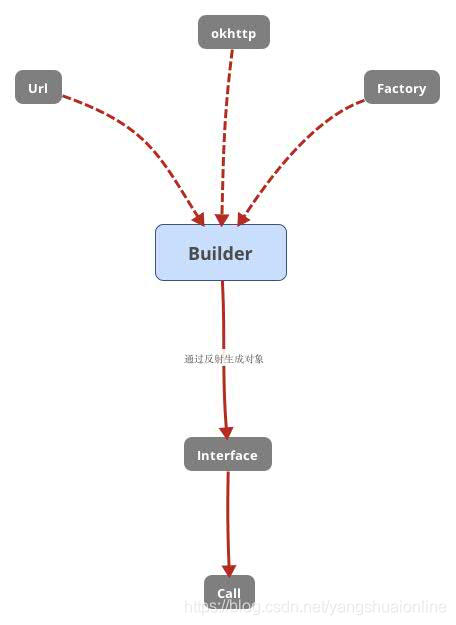总体流程图:

先看一段代码:
Retrofit retrofit = new Retrofit.Builder()
.baseUrl("http://10.0.2.2:8080")
.addConverterFactory(GsonConverterFactory.create())
.build();
APIInterface service = retrofit.create(APIInterface.class);
try {
Call<ModelEntity> call = service.getEntity("aaa","123");
call.enqueue(new Callback<ModelEntity>() {
@Override
public void onResponse(Call<ModelEntity> call, Response<ModelEntity> response) {
ModelEntity entity = response.body();
String result = entity.toString();
Log.w("打印", "结果是"+result);
}
@Override
public void onFailure(Call<ModelEntity> call, Throwable t) {
Log.w("打印", "onFailure结果是"+t.toString());
}
});
}catch (Exception e){
Log.w("打印", e.toString());
}
一、先看new Retrofit.Builder()的源码:
Builder(Platform platform) {
this.platform = platform;
}
这句就是用来确定平台的,然后找到确定平台的代码:
private static Platform findPlatform() {
try {
Class.forName("android.os.Build");
if (Build.VERSION.SDK_INT != 0) {
return new Android();
}
} catch (ClassNotFoundException ignored) {
}
...
return new Platform();
}
由于我用的是Android平台的,就只看Android相关代码了,不过这里用try catch来判断是不是Android平台我也挺惊讶的,至少之前看过的帖子都说不建议用try catch来判断。如果是Android平台,会返回一个Android对象。
这个过程就是初始化一个Android对象放倒Builder中。
看第二句:baseUrl(…)
public Builder baseUrl(String baseUrl) {
...
return baseUrl(HttpUrl.get(baseUrl));
}
这里调用okhttp的HttpUrl.get(String) 方法,生成了一个HttpUrl对象,然后该对象传给baseUrl方法。
public Builder baseUrl(HttpUrl baseUrl) {
...
this.baseUrl = baseUrl;
return this;
}
这个过程就是生成一个HttpUrl对象,然后放到Builder对象中。
第三步,添加转换器工厂:
public Builder addConverterFactory(Converter.Factory factory) {
converterFactories.add(checkNotNull(factory, "factory == null"));
return this;
}
这里添加是为了支持Gson格式,如果不添加的话,会爆出java.lang.IllegalArgumentException: Unable to create converter for class … for method …异常。
第四步,调用builder():
public Retrofit build() {
...
//配置okhttp
okhttp3.Call.Factory callFactory = this.callFactory;
if (callFactory == null) {
callFactory = new OkHttpClient();
}
Executor callbackExecutor = this.callbackExecutor;
if (callbackExecutor == null) {
callbackExecutor = platform.defaultCallbackExecutor();
}
// Make a defensive copy of the adapters and add the default Call adapter.
List<CallAdapter.Factory> callAdapterFactories = new ArrayList<>(this.callAdapterFactories);
callAdapterFactories.addAll(platform.defaultCallAdapterFactories(callbackExecutor));
// Make a defensive copy of the converters.
List<Converter.Factory> converterFactories = new ArrayList<>(
1 + this.converterFactories.size() + platform.defaultConverterFactoriesSize());
// Add the built-in converter factory first. This prevents overriding its behavior but also
// ensures correct behavior when using converters that consume all types.
converterFactories.add(new BuiltInConverters());
converterFactories.addAll(this.converterFactories);
converterFactories.addAll(platform.defaultConverterFactories());
return new Retrofit(callFactory, baseUrl, unmodifiableList(converterFactories),
unmodifiableList(callAdapterFactories), callbackExecutor, validateEagerly);
}
callAdapterFactories、converterFactories、callbackExecutor、validateEagerly这几个对象暂时没看出来什么意思,暂时过,留到后边用到分析。
看Retrofit的构造方法:
Retrofit(okhttp3.Call.Factory callFactory, HttpUrl baseUrl,
List<Converter.Factory> converterFactories,
List<CallAdapter.Factory> callAdapterFactories,
@Nullable Executor callbackExecutor,
boolean validateEagerly) {
this.callFactory = callFactory;
this.baseUrl = baseUrl;
this.converterFactories = converterFactories; // Copy+unmodifiable at call site.
this.callAdapterFactories = callAdapterFactories; // Copy+unmodifiable at call site.
this.callbackExecutor = callbackExecutor;
this.validateEagerly = validateEagerly;
}
到此,Retrofit初始化完成。
五、初始化APIInterface:
public <T> T create(final Class<T> service) {
...
if (validateEagerly) {
//解析接口中的方法(这里知识做异常判断)
eagerlyValidateMethods(service);
}
//根据反射生成接口实现类
return (T) Proxy.newProxyInstance(service.getClassLoader(), new Class<?>[] { service },
new InvocationHandler() {
private final Platform platform = Platform.get();
private final Object[] emptyArgs = new Object[0];
@Override public Object invoke(Object proxy, Method method, @Nullable Object[] args)
throws Throwable {
// If the method is a method from Object then defer to normal invocation.
if (method.getDeclaringClass() == Object.class) {
return method.invoke(this, args);
}
if (platform.isDefaultMethod(method)) {
return platform.invokeDefaultMethod(method, service, proxy, args);
}
return loadServiceMethod(method).invoke(args != null ? args : emptyArgs);
}
});
}
通过反射,依据接口生成请求实体,然后调用接口中方法,返回Call对象,然后调用enqueue方法处理回调。
六、处理回调:
Call<ModelEntity> call = service.getEntity("aaa","123");
call.enqueue(new Callback<ModelEntity>() {
@Override
public void onResponse(Call<ModelEntity> call, Response<ModelEntity> response) {
ModelEntity entity = response.body();
String result = entity.toString();
Log.w("打印", "结果是"+result);
}
@Override
public void onFailure(Call<ModelEntity> call, Throwable t) {
Log.w("打印", "onFailure结果是"+t.toString());
}
});
前面通过反射生成请求对象了之后,直接调用对象中的方法发出请求,然后onResponse中处理请求回调。
七、反射的流程
重点看如代码:
return (T) Proxy.newProxyInstance(service.getClassLoader(), new Class<?>[] { service },
new InvocationHandler() {
...
@Override public Object invoke(Object proxy, Method method, @Nullable Object[] args)
throws Throwable {
...
return loadServiceMethod(method).invoke(args != null ? args : emptyArgs);
}
});
然后关联到loadServiceMethod方法中:
private final Map<Method, ServiceMethod<?>> serviceMethodCache = new ConcurrentHashMap<>();
ServiceMethod<?> loadServiceMethod(Method method) {
...
synchronized (serviceMethodCache) {
result = serviceMethodCache.get(method);
if (result == null) {
result = ServiceMethod.parseAnnotations(this, method);
...
}
}
return result;
}
然后关联到ServiceMethod.parseAnnotations(this, method);方法中
static <T> ServiceMethod<T> parseAnnotations(Retrofit retrofit, Method method) {
// 处理方法注释,配置请求类型和入参,返回一个请求对象。
RequestFactory requestFactory = RequestFactory.parseAnnotations(retrofit, method);
// 方法的返回类型
Type returnType = method.getGenericReturnType();
...
// 将接口的调用转为Http调用
return HttpServiceMethod.parseAnnotations(retrofit, method, requestFactory);
}
配置网络请求
RequestFactory build() {
//遍历方法注解,确定请求类型。
for (Annotation annotation : methodAnnotations) {
parseMethodAnnotation(annotation);
}
...
//根据方法参数注解,入参。
int parameterCount = parameterAnnotationsArray.length;
parameterHandlers = new ParameterHandler<?>[parameterCount];
for (int p = 0; p < parameterCount; p++) {
parameterHandlers[p] = parseParameter(p, parameterTypes[p], parameterAnnotationsArray[p]);
}
...
//返回一个请求对象。
return new RequestFactory(this);
}
static <ResponseT, ReturnT> HttpServiceMethod<ResponseT, ReturnT> parseAnnotations(
Retrofit retrofit, Method method, RequestFactory requestFactory) {
//前面没有添加addCallAdapterFactory,暂时不考虑此属性。
CallAdapter<ResponseT, ReturnT> callAdapter = createCallAdapter(retrofit, method);
Type responseType = callAdapter.responseType();
...
Converter<ResponseBody, ResponseT> responseConverter =
createResponseConverter(retrofit, method, responseType);
//调用之前(第四步)初始化配置的网络请求
okhttp3.Call.Factory callFactory = retrofit.callFactory;
return new HttpServiceMethod<>(requestFactory, callFactory, callAdapter, responseConverter);
}
返回了一个持有requestFactory, callFactory, callAdapter, responseConverter的HttpServiceMethod,然后再调用invoke方法返回请求实体。然后返回到第五步中,成功返回请求对象。